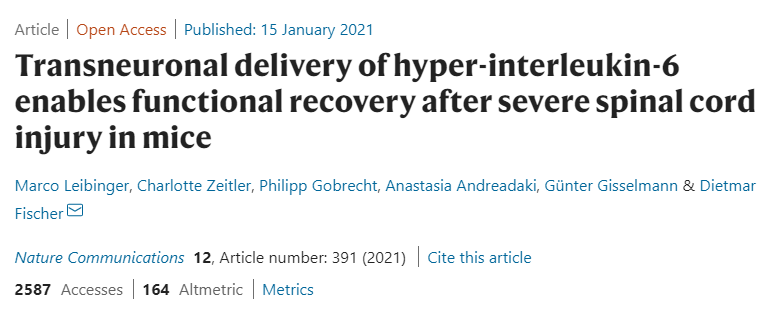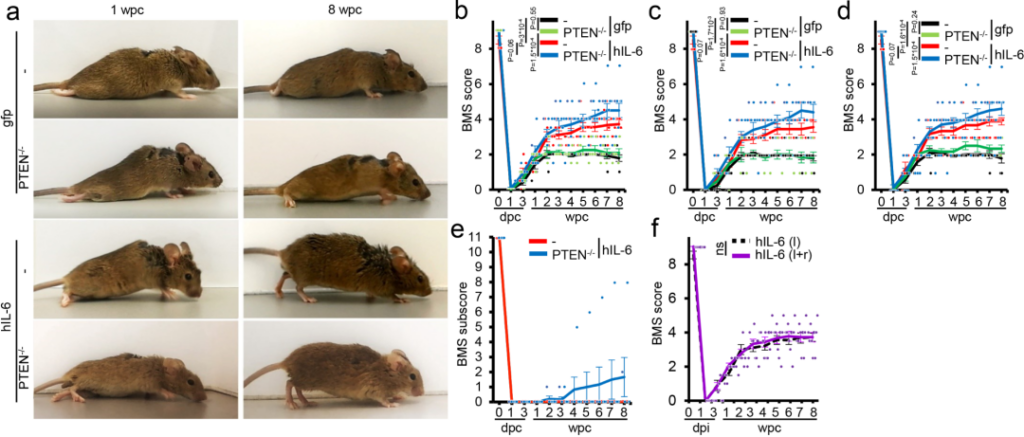AAV gene restores walking ability in paralyzed mice
- Normal Liver Cells Found to Promote Cancer Metastasis to the Liver
- Nearly 80% Complete Remission: Breakthrough in ADC Anti-Tumor Treatment
- Vaccination Against Common Diseases May Prevent Dementia!
- New Alzheimer’s Disease (AD) Diagnosis and Staging Criteria
- Breakthrough in Alzheimer’s Disease: New Nasal Spray Halts Cognitive Decline by Targeting Toxic Protein
- Can the Tap Water at the Paris Olympics be Drunk Directly?
AAV gene restores walking ability in paralyzed mice
AAV gene restores the walking ability of paralyzed mice. Nature: AAV gene therapy successfully restored the walking ability of paralyzed mice.
The next step will be to continue research on mice to determine whether the treatment will have similar therapeutic effects a few weeks after spinal cord injury in mice. In the long run, the results of this study may benefit humans.
Spinal cord injury is the most serious complication of spinal cord injury. Damaged nerve fibers may no longer be able to transmit signals between the brain and muscles. This regenerative failure usually leads to severe and permanent disability, such as paraplegia or quadriplegia after spinal cord injury, and worse, these axons It cannot be regenerated. So far, there is no clinical cure.
On January 15, 2021, researchers from Ruhr University Bochum, Germany, published a research paper titled: Transneuronal delivery of hyper-interleukin-6 enables functional recovery after severe spinal cord injury in mice in Nature Communications.
Researchers created an artificially engineered protein-Hyper-IL-6 (Hyper-IL-6, hIL-6), which was injected into the mouse brain through the AAV virus vector to stimulate nerve cell regeneration and restore the complete spinal cord The walking ability of paralyzed mice after injury.

Previous studies have shown that through spinal stimulation therapy, or completely bypassing the injury site, it is possible to restore some limb functions. Other promising studies in similar fields include the use of compounds to restore the balance of inhibitory and excitatory signals in the neurons of partially paralyzed mice, and transplantation of regenerated nasal nerve cells into the spine of injured dogs.
The research was achieved by unilateral transduction of cortical motor neurons and AAV expressing super interleukin-6 (hIL-6), which is an effective cytokine that stimulates JAK/STAT3 signaling and axon regeneration .
hIL-6 protein, a synthetic form of a naturally occurring polypeptide, can stimulate nerve cell regeneration after adjustment.
The author said that this is a so-called design cytokine, which means that it does not exist in nature and must be produced by genetic engineering.
In the study, the team tested hIL-6 on mice. The spinal cord of the mice was completely shattered, resulting in loss of function of both hind legs.
The researchers packaged the gene sequence expressing hIL-6 into AAV viral vectors and injected these viruses into the sensorimotor cortex of mice.

Motor neurons near the injection site not only start to produce hIL-6 by themselves, but also transmit it to other neurons responsible for walking and other actions through axon collaterals. This trans-neuronal transmission of hIL-6 promoted the regeneration of cortical spinal cord and raphe nerve fibers after injury. Within 2-3 weeks, the mice recovered their walking ability. Even within a few weeks after a single injection, the hind legs of the mice were able to recover function.
According to the author, gene therapy for only a few nerve cells can simultaneously stimulate the regeneration of various nerve cells in the brain and several motor tracts in the spinal cord. In the end, the paralyzed animals that received the treatment started walking after two to three weeks.
Although the results are shockingly good, it is clear that the study is still in its early stages. The research team said that the next step will continue to study in mice to determine if the mice will be treated a few weeks after spinal cord injury. In the long run, the results of this study may benefit mankind.
(source:internet, reference only)
Disclaimer of medicaltrend.org



